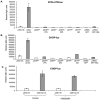The SARS Coronavirus 3a protein causes endoplasmic reticulum stress and induces ligand-independent downregulation of the type 1 interferon receptor
- PMID: 20020050
- PMCID: PMC2791231
- DOI: 10.1371/journal.pone.0008342
The SARS Coronavirus 3a protein causes endoplasmic reticulum stress and induces ligand-independent downregulation of the type 1 interferon receptor
Abstract
The Severe Acute Respiratory Syndrome Coronavirus (SARS-CoV) is reported to cause apoptosis of infected cells and several of its proteins including the 3a accessory protein, are pro-apoptotic. Since the 3a protein localizes to the endoplasmic reticulum (ER)-Golgi compartment, its role in causing ER stress was investigated in transiently transfected cells. Cells expressing the 3a proteins showed ER stress based on activation of genes for the ER chaperones GRP78 and GRP94. Since ER stress can cause differential modulation of the unfolded protein response (UPR), which includes the inositol-requiring enzyme 1 (IRE-1), activating transcription factor 6 (ATF6) and PKR-like ER kinase (PERK) pathways, these were individually tested in 3a-expressing cells. Only the PERK pathway was found to be activated in 3a-expressing cells based on (1) increased phosphorylation of eukaryotic initiation factor 2 alpha (eIF2alpha) and inhibitory effects of a dominant-negative form of eIF2alpha on GRP78 promoter activity, (2) increased translation of activating transcription factor 4 (ATF4) mRNA, and (3) ATF4-dependent activation of the C/EBP homologous protein (CHOP) gene promoter. Activation of PERK affects innate immunity by suppression of type 1 interferon (IFN) signaling. The 3a protein was found to induce serine phosphorylation within the IFN alpha-receptor subunit 1 (IFNAR1) degradation motif and to increase IFNAR1 ubiquitination. Confocal microscopic analysis showed increased translocation of IFNAR1 into the lysosomal compartment and flow cytometry showed reduced levels of IFNAR1 in 3a-expressing cells. These results provide further mechanistic details of the pro-apoptotic effects of the SARS-CoV 3a protein, and suggest a potential role for it in attenuating interferon responses and innate immunity.
Conflict of interest statement
Figures






Similar articles
-
The Human Cytomegalovirus Endoplasmic Reticulum-Resident Glycoprotein UL148 Activates the Unfolded Protein Response.J Virol. 2018 Sep 26;92(20):e00896-18. doi: 10.1128/JVI.00896-18. Print 2018 Oct 15. J Virol. 2018. PMID: 30045994 Free PMC article.
-
The PERK/PKR-eIF2α Pathway Negatively Regulates Porcine Hemagglutinating Encephalomyelitis Virus Replication by Attenuating Global Protein Translation and Facilitating Stress Granule Formation.J Virol. 2022 Jan 12;96(1):e0169521. doi: 10.1128/JVI.01695-21. Epub 2021 Oct 13. J Virol. 2022. PMID: 34643429 Free PMC article.
-
The eIF2 kinase PERK and the integrated stress response facilitate activation of ATF6 during endoplasmic reticulum stress.Mol Biol Cell. 2011 Nov;22(22):4390-405. doi: 10.1091/mbc.E11-06-0510. Epub 2011 Sep 14. Mol Biol Cell. 2011. PMID: 21917591 Free PMC article.
-
Endoplasmic reticulum stress and eIF2α phosphorylation: The Achilles heel of pancreatic β cells.Mol Metab. 2017 Jul 12;6(9):1024-1039. doi: 10.1016/j.molmet.2017.06.001. eCollection 2017 Sep. Mol Metab. 2017. PMID: 28951826 Free PMC article. Review.
-
The Role of the PERK/eIF2α/ATF4/CHOP Signaling Pathway in Tumor Progression During Endoplasmic Reticulum Stress.Curr Mol Med. 2016;16(6):533-44. doi: 10.2174/1566524016666160523143937. Curr Mol Med. 2016. PMID: 27211800 Free PMC article. Review.
Cited by
-
Virus Caused Imbalance of Type I IFN Responses and Inflammation in COVID-19.Front Immunol. 2021 Apr 12;12:633769. doi: 10.3389/fimmu.2021.633769. eCollection 2021. Front Immunol. 2021. PMID: 33912161 Free PMC article. Review.
-
Identification of residues of SARS-CoV nsp1 that differentially affect inhibition of gene expression and antiviral signaling.PLoS One. 2013 Apr 29;8(4):e62416. doi: 10.1371/journal.pone.0062416. Print 2013. PLoS One. 2013. PMID: 23658627 Free PMC article.
-
The Emerging Roles of Viroporins in ER Stress Response and Autophagy Induction during Virus Infection.Viruses. 2015 Jun 4;7(6):2834-57. doi: 10.3390/v7062749. Viruses. 2015. PMID: 26053926 Free PMC article. Review.
-
Role of the early secretory pathway in SARS-CoV-2 infection.J Cell Biol. 2020 Sep 7;219(9):e202006005. doi: 10.1083/jcb.202006005. J Cell Biol. 2020. PMID: 32725137 Free PMC article. Review.
-
The interferons and their receptors--distribution and regulation.Immunol Cell Biol. 2012 May;90(5):483-91. doi: 10.1038/icb.2012.9. Epub 2012 Mar 13. Immunol Cell Biol. 2012. PMID: 22410872 Free PMC article. Review.
References
-
- Drosten C, Gunther S, Preiser W, van der Werf S, Brodt HR, et al. Identification of a novel coronavirus in patients with severe acute respiratory syndrome. N Engl J Med. 2003;348:1967–1976. - PubMed
-
- Marra MA, Jones SJ, Astell CR, Holt RA, Brooks-Wilson A, et al. The Genome sequence of the SARS-associated coronavirus. Science. 2003;300:1399–1404. - PubMed
-
- Rota PA, Oberste MS, Monroe SS, Nix WA, Campagnoli R, et al. Characterization of a novel coronavirus associated with severe acute respiratory syndrome. Science. 2003;300:1394–1399. - PubMed
Publication types
MeSH terms
Substances
LinkOut - more resources
Full Text Sources
Other Literature Sources
Molecular Biology Databases
Research Materials
Miscellaneous

